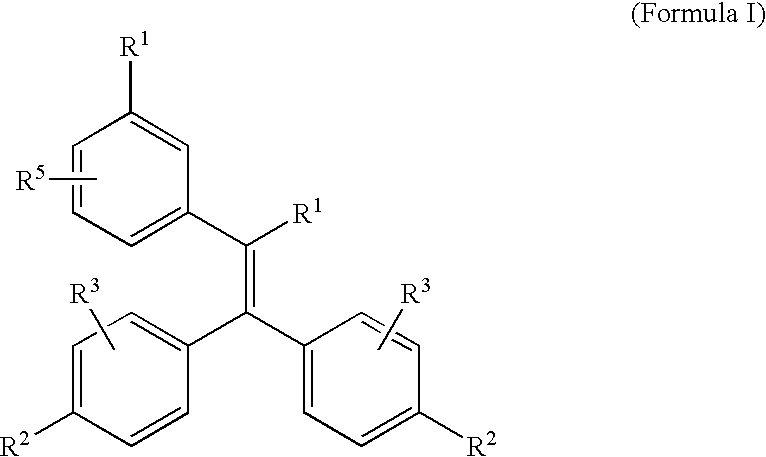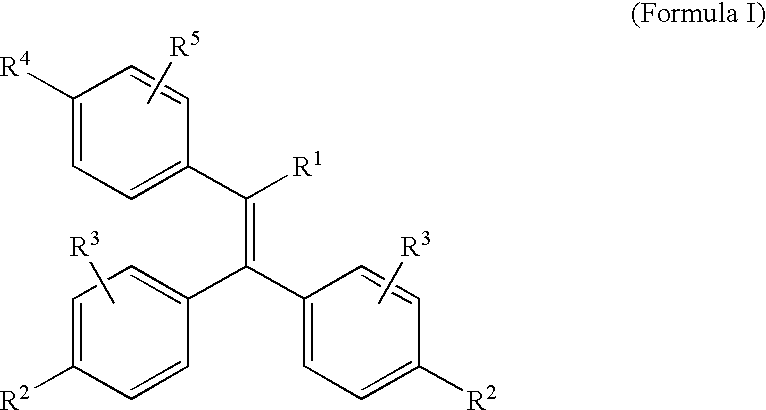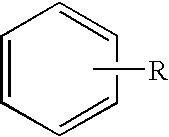Triphenylethylene Compounds Useful as Selective Estrogen Receptor Modulators
a technology of triphenylethylene and selective estrogen receptor, applied in the field of compound, can solve the problems of increasing the economic burden of osteoporosis, and increasing the risk of fracture, so as to prevent osteoporosis and/or treat conditions. the effect of prophylaxis and treatmen
- Summary
- Abstract
- Description
- Claims
- Application Information
AI Technical Summary
Benefits of technology
Problems solved by technology
Method used
Image
Examples
example 1 (
3)
({4-[1-Butyl-2,2-bis(4-hydroxyphenyl)ethenyl]phenyl}oxy)acetic acid (3)
[0130]
Step 1: Ethyl[(4-pentanoylphenyl)oxy]acetate (1)
[0131]A round-bottom flask was charged with 1-(4-hydroxyphenyl)-1-pentanone (5.34 g, 30.0 mmol), ethyl bromoacetate (8.3 mL, 75.0 mmol), K2CO3 (8.3 g, 60 mmol), and acetone (200 mL) under N2. The reaction mixture was refluxed for 4 h. After cooling to room temperature the reaction mixture was filtered and the filtrate concentrated under reduced pressure to give the crude product. The crude product was purified by flash SiO2 column chromatography with hexanes: EtOAc (19:1 to 4:1) to yield 7.90 g (˜100%) of the title compound 1 as a white solid. 1H NMR (300 MHz, CDCl3): δ 0.96 (t, J=7.6 Hz, 3H), 1.32 (t, J=7.6 Hz, 3H), 1.43 (app. sextet, J=7.6 Hz, 1H), 1.72 (app. quintet, J=7.6 Hz, 1H), 2.93 (t, J=7.6 Hz, 2H), 4.30 (q, J=7.0 Hz, 2H), 4.69 (s, 2H), 6.95 (d, J=8.7 Hz, 2H), 7.96 (d, J=8.7 Hz, 2H). LCMS (ESI): m / z 265 (M+H)+.
Step 2: Ethyl ({4-[1-butyl-2,2-bis(4-hy...
example 2 (
6)
({4-[2,2-Bis(4-hydroxyphenyl)-1-propylethenyl]phenyl}oxy)acetic acid
[0134]
Step 1: Ethyl[(4-butanoylphenyl)oxy]acetate (4)
[0135]The general O-alkylation procedure described for 1 (Example 1, Step 1) was employed using 1-(4-hydroxyphenyl)-1-butanone (5.0 g, 30.5 mmol) and ethyl bromoacetate (8.7 g, 61.0 mmol). Standard work-up followed by purification gave 7.6 g (99%) of the title compound 4 as a white solid. 1H NMR (300 MHz, CDCl3)): δ 1.00 (t, J=7.2 Hz, 3H), 1.32 (t, J=7.0 Hz, 3H), 1.77 (app. sextet, J=7.6 Hz, 2H), 2.91 (t, J=7.2 Hz, 2H), 6.95 (d, J=8.8 Hz, 2H), 7.96 (d, J=9.0 Hz, 2H). LCMS (ESI): m / z 251 (M+H)+.
Step 2: Ethyl ({4-[2,2-bis(4-hydroxyphenyl)-1-propylethenyl]phenyl}oxy)acetate (5)
[0136]The general McMurry coupling procedure described for 2 (Example 1, step 2) was employed with bis(4-hydroxyphenyl)methanone (1.43 g, 6.67 mmol) and ester 4 (5.0 g, 20.0 mmol). The standard work-up followed by purification gave 2.56 g (89%) of the title compound 5 as an off-white foam. 1H...
example 3 (
9)
[(4-{1-Ethyl-2,2-bis[4-(methyloxy)phenyl]ethenyl}phenyl)oxy]acetic acid (9)
[0138]
Step 1: 4-{1-Ethyl-2,2-bis[4-(methyloxy)phenyl]ethenyl}phenol (7)
[0139]The general McMurry coupling procedure described for 2 (Example 1, step 2) was employed using bis[4-(methyloxy)phenyl]methanone (4.84 g, 20.0 mmol) and 1-(4-hydroxyphenyl)-1-propanone (9.0 g, 60.0 mmol). Standard work-up followed by purification gave 3.60 g (50%) of the title product 7 as a white solid. 1H NMR (400 MHz, CDCl3): δ 0.92 (t, J=7.6 Hz, 3H), 2.44 (q, J=7.2 Hz, 2H), 3.69 (s, 3H), 3.82 (s, 3H), 6.56 (d, J=8.4 Hz, 2H), 6.63 (d, J=8.4 Hz, 2H), 6.77 (d, J=8.4 Hz, 2H), 6.87 (d, J=8.8 Hz, 2H), 6.97 (d, J=8.8 Hz, 2H), 7.13 (d, J=8.4 Hz, 2H). LCMS (ESI): m / z 361 (M+H)+.
Step 2: Ethyl[(4-{1-ethyl-2,2-bis[4-(methyloxy)phenyl]ethenyl}phenyl)oxy]acetate (8)
[0140]The O-alkylation procedure described for compound 1 (Example 1, Step 1) was employed using 4-{1-ethyl-2,2-bis[4-(methyloxy)phenyl]ethenyl}phenol 7 (0.850 g, 2.36 mmol), ethyl...
PUM
 Login to View More
Login to View More Abstract
Description
Claims
Application Information
 Login to View More
Login to View More - R&D
- Intellectual Property
- Life Sciences
- Materials
- Tech Scout
- Unparalleled Data Quality
- Higher Quality Content
- 60% Fewer Hallucinations
Browse by: Latest US Patents, China's latest patents, Technical Efficacy Thesaurus, Application Domain, Technology Topic, Popular Technical Reports.
© 2025 PatSnap. All rights reserved.Legal|Privacy policy|Modern Slavery Act Transparency Statement|Sitemap|About US| Contact US: help@patsnap.com



